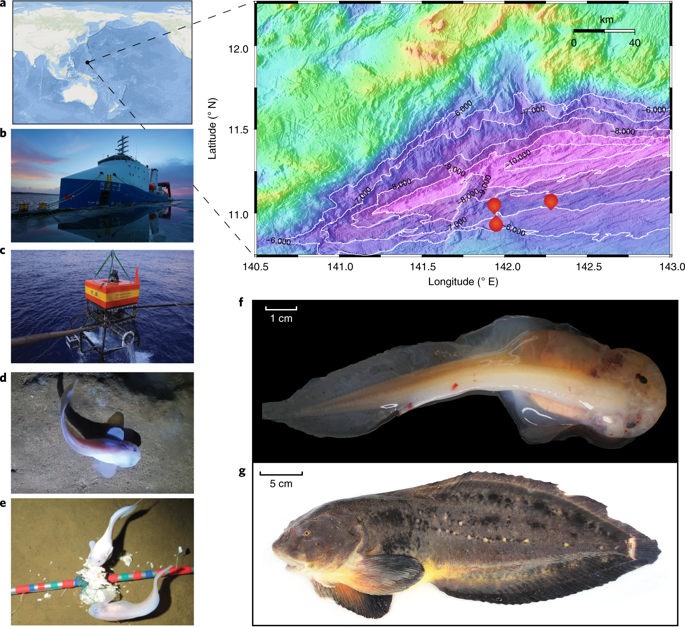Nature Ecology & Evolution ( IF 13.9 ) Pub Date : 2019-04-15 , DOI: 10.1038/s41559-019-0864-8
Kun Wang 1, 2 , Yanjun Shen 3, 4 , Yongzhi Yang 5 , Xiaoni Gan 3 , Guichun Liu 1 , Kuang Hu 1 , Yongxin Li 1 , Zhaoming Gao 2 , Li Zhu 5 , Guoyong Yan 2 , Lisheng He 2 , Xiujuan Shan 6 , Liandong Yang 3 , Suxiang Lu 3 , Honghui Zeng 3 , Xiangyu Pan 7 , Chang Liu 1 , Yuan Yuan 1 , Chenguang Feng 1 , Wenjie Xu 1 , Chenglong Zhu 1 , Wuhan Xiao 3 , Yang Dong 8 , Wen Wang 1, 9, 10 , Qiang Qiu 1, 5, 9 , Shunping He 2, 3, 4, 10

|
It is largely unknown how living organisms—especially vertebrates—survive and thrive in the coldness, darkness and high pressures of the hadal zone. Here, we describe the unique morphology and genome of Pseudoliparis swirei—a recently described snailfish species living below a depth of 6,000 m in the Mariana Trench. Unlike closely related shallow sea species, P. swirei has transparent, unpigmented skin and scales, thin and incompletely ossified bones, an inflated stomach and a non-closed skull. Phylogenetic analyses show that P. swirei diverged from a close relative living near the sea surface about 20 million years ago and has abundant genetic diversity. Genomic analyses reveal that: (1) the bone Gla protein (bglap) gene has a frameshift mutation that may cause early termination of cartilage calcification; (2) cell membrane fluidity and transport protein activity in P. swirei may have been enhanced by changes in protein sequences and gene expansion; and (3) the stability of its proteins may have been increased by critical mutations in the trimethylamine N-oxide-synthesizing enzyme and hsp90 chaperone protein. Our results provide insights into the morphological, physiological and molecular evolution of hadal vertebrates.
中文翻译:

马里亚纳海沟的一只蜗牛的形态和基因组提供了对深海适应的见解
目前尚不清楚生物体——尤其是脊椎动物——是如何在寒冷、黑暗和高压的下海带中生存和繁衍的。在这里,我们描述了Pseudoliparis swirei的独特形态和基因组,这是一种最近描述的生活在马里亚纳海沟 6,000 m 深度以下的蜗牛物种。与密切相关的浅海物种不同,P. swirei具有透明、无色素的皮肤和鳞片、薄且不完全骨化的骨骼、膨胀的胃和未闭合的颅骨。系统发育分析表明,P. swirei大约在 2000 万年前与生活在海面附近的近亲分道扬镳,具有丰富的遗传多样性。基因组分析表明:(1) 骨 Gla 蛋白 ( bglap) 基因有可能导致软骨钙化提前终止的移码突变;(2) P. swirei的细胞膜流动性和转运蛋白活性可能因蛋白质序列的变化和基因扩增而增强;(3) 三甲胺N-氧化物合成酶和 hsp90 伴侣蛋白的关键突变可能增加了其蛋白质的稳定性。我们的研究结果为深渊脊椎动物的形态、生理和分子进化提供了见解。































 京公网安备 11010802027423号
京公网安备 11010802027423号